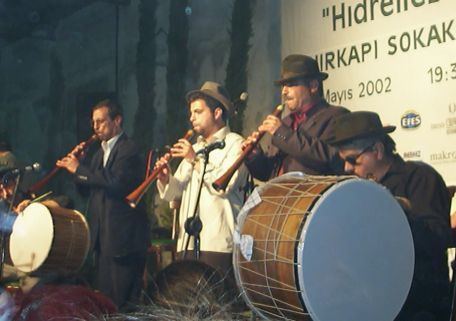 | ||
Circular breathing is a technique used by players of some wind instruments to produce a continuous tone without interruption. This is accomplished by breathing in through the nose while simultaneously pushing air out through the mouth using air stored in the cheeks.
Contents
History
The technique was developed independently by several cultures, and is used for many traditional wind instruments.
In the 13th century, Asian metalsmiths who specialized in gold and silver used circular breathing techniques for crafting various decorative and ornamental items. In crafting such items, craftsmen were required to blow continuously to the flame through a pipe with a needle-like hole, in order to make the hard metal melt or soften. From such necessity, craftsmen mastered a circular-like cycle of breathing, simultaneously inhaling through their nose while blowing without any pauses. The introduction of the circular breathing technique in the art of ancient windplayers was a productive invention in its performing technique.
Uses
It is used extensively in playing the Eastern zurna, the Mongolian limbe, the Sardinian launeddas, the Egyptian arghul, the Australian didgeridoo, as well as many traditional oboes and flutes of Asia and the Middle East. A few jazz and classical wind and brass players also use some form of circular breathing.
Although many professional wind players find circular breathing highly useful, few pieces of European orchestral music composed before the 20th century actually require its use. However, the advent of circular breathing among professional wind players has allowed for the transcription of pieces originally composed for string instruments which would be unperformable on a wind instrument without the aid of circular breathing. A notable example of this phenomenon is "Moto Perpetuo", transcribed for trumpet by Rafael Méndez from the original work for violin by Paganini.
In 1997, a Guinness World Record was set for longest held musical note. Kenny G used circular breathing to sustain an E-flat on a saxophone for 45 minutes and 47 seconds. On February 2000, Vann Burchfield set a new Guinness world record for circular breathing, holding one continuous note for 47 minutes, 6 seconds, surpassing Kenny G’s record. Mark Atkins on Didgeridoo Concerto (1994) plays for over 50 minutes continuously.
Performing
The musician inhales fully and begins to exhale and blow. When the lungs are nearly empty, the last volume of air is blown into the mouth, and the cheeks are inflated with part of this air. Then, while still blowing this last bit of air out by squeezing the cheeks, the musician must very quickly fill the lungs by inhaling through the nose prior to running out of the air in the mouth. If done correctly, by the time the air in the mouth is nearly exhausted the musician can begin to exhale from the lungs once more, ready to repeat the process again. Essentially, circular breathing bridges the gap between exhalations with air stored in the cheeks, an extra air reserve to play with while sneaking in a breath through the nose.
Learning
The usual first difficulty is to inhale through the nose while blowing out air stored in the cheeks. To some this may be a big hurdle, to others no problem at all. One can practice this anywhere anytime by holding a finger in front of a thin air stream out of the lips and listen to the wind sound.
The next difficulty is to switch between cheek air and lung air without an unwelcome and uncontrolled jolt in the air pressure; one must learn to use the cheeks and the throat as a system of shock absorbents. A very simple method to practice this is using a thin straw to blow on the surface of a cup of water, and watch the depression that the air stream creates on the water's surface. The aim is to blow continually and switch between cheek air and lung air without any change in the depth of this depression.
The traditional method of learning in zurna groups is to have one elder player lead as the chanter zurna and ask the younger players to hold the unchanging "drone tone"s. Professional zurna groups may play non-stop for as long as the party lasts, and a drone tone may be held for the whole evening.
